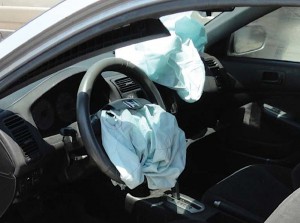The recent death of an Australian man due to faulty Takata airbags brings the global total of deaths attributable to them to 18, although it was the first fatality in Australia.
Investigators told Reuters the man was struck in the neck by a small fragment of an airbag that was subject to recall. Takata’s airbag inflators can degrade over time, spraying metal shards around a vehicle when the airbag is deployed.
Honda officials said the accident was still under investigation and were not able to determine whether the airbag in question was an original model or a replacement. Takata did not respond to a request for comment.
The ongoing investigation didn’t stop a class-action lawsuit from being filed against Toyota, Honda and Mazda. The suit seeks refunds for vehicles equipped with the faulty airbags. The suit was filed based on a law that says consumers are entitled to refunds if a product has a fault that makes it unsafe and the problem cannot be resolved in a timely manner.
(Takata’s “fix” for its exploding airbags may not work. To see why, Click Here.)
In addition to the aforementioned deaths, there have been more than 180 injuries associated with the airbags, which have chemicals that can degrade over time, causing the ignitors to explode with too much force, sending pieces of shrapnel into the vehicle cabin.
The Australian Competition and Consumer Commission, a consumer watchdog group, said that it was looking into the matter, primarily to make sure that consumers are getting the information they need about the recall.
ACCC officials said that just 36% of affected vehicles have had the recall work performed — a percentage that mirrors responses in America. The recall affected 2.3 million vehicles in Australia since 2009, the group noted.
The faulty airbags have ultimately driven Takata into bankruptcy protection in the U.S. and Japan. In the U.S., Key Safety Systems is in the process of working out a plan to buy the company’s assets, but has run into issues finalizing the deal.
(Click Here for more about Takata’s bankruptcy filings.)
Furthermore, it was recently revealed that the vehicles that have gone in to repair the faulty airbags may actually have to be recalled again. When Takata offered up a solution to the problem in 2015, U.S. regulators said the company had just four years to make sure that it worked.
The supplier added a drying agent to combat moisture that can set off the ammonium nitrate compound in an inflator.
If the airbag inflators fail or are deemed unsafe, the replacements will need to replaced. According to Reuters, some industry consultants, explosives experts and former employees question whether the workaround guarantees safety over the long-term.
“Absent proof that the other desiccated inflators are safe, they will also be subject to recall,” the U.S. National Highway Traffic Safety Administration (NHTSA) said in a statement last week. The agency declined to comment on the risk that additional inflators may be subject to recall, Reuters reported.
Recently, NHTSA revealed that testing on the Takata replacement inflators revealed that 2.7 million were defected and the agency issued a recall. The testing showed it was possible that moisture can still get into the inflators.
(Another 2.7 million Takata airbags recalled. To find out why, Click Here.)
Takata officials said they produced 100 million replacements using drying agents to control the moisture issue. The 2.7 million vehicles recalled used calcium sulfate; however, the remainder used zeolite.

